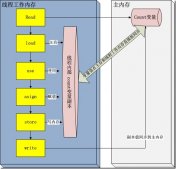自动装箱就是Java自动将原始类型值转换成对应的对象,比如将int的变量转换成Integer对象,这个过程叫做装箱,反之将Integer对象转换成int类型值,这个过程叫做拆箱。因为这里的装箱和拆箱是自动进行的非人为转换,所以就称作为自动装箱和拆箱。原始类型byte, short, char, int, long, float, double 和 boolean 对应的封装类为Byte, Short, Character, Integer, Long, Float, Double, Boolean。
下面例子是自动装箱和拆箱带来的疑惑
|
1
2
3
4
5
6
7
8
9
10
11
12
13
14
15
16
17
18
19
20
21
22
23
24
25
26
27
|
public class Test { public static void main(String[] args) { test(); } public static void test() { int i = 40; int i0 = 40; Integer i1 = 40; Integer i2 = 40; Integer i3 = 0; Integer i4 = new Integer(40); Integer i5 = new Integer(40); Integer i6 = new Integer(0); Double d1=1.0; Double d2=1.0; System.out.println("i=i0\t" + (i == i0)); System.out.println("i1=i2\t" + (i1 == i2)); System.out.println("i1=i2+i3\t" + (i1 == i2 + i3)); System.out.println("i4=i5\t" + (i4 == i5)); System.out.println("i4=i5+i6\t" + (i4 == i5 + i6)); System.out.println("d1=d2\t" + (d1==d2)); System.out.println(); } } |
请看下面的输出结果跟你预期的一样吗?
输出的结果:
i=i0 true
i1=i2 true
i1=i2+i3 true
i4=i5 false
i4=i5+i6 true
d1=d2 false
为什么会这样?带着疑问继续往下看。
自动装箱和拆箱的原理
自动装箱时编译器调用valueOf将原始类型值转换成对象,同时自动拆箱时,编译器通过调用类似intValue(),doubleValue()这类的方法将对象转换成原始类型值。
明白自动装箱和拆箱的原理后,我们带着上面的疑问进行分析下Integer的自动装箱的实现源码。如下:
|
1
2
3
4
5
6
7
8
9
10
11
12
13
14
15
16
17
18
19
20
21
22
23
24
25
26
27
28
29
30
31
32
33
34
35
36
37
38
39
40
41
42
43
|
public static Integer valueOf(int i) { //判断i是否在-128和127之间,如果不在此范围,则从IntegerCache中获取包装类的实例。否则new一个新实例 if (i >= IntegerCache.low && i <= IntegerCache.high) return IntegerCache.cache[i + (-IntegerCache.low)]; return new Integer(i);}//使用亨元模式,来减少对象的创建(亨元设计模式大家有必要了解一下,我认为是最简单的设计模式,也许大家经常在项目中使用,不知道他的名字而已)private static class IntegerCache { static final int low = -128; static final int high; static final Integer cache[]; //静态方法,类加载的时候进行初始化cache[],静态变量存放在常量池中 static { // high value may be configured by property int h = 127; String integerCacheHighPropValue = sun.misc.VM.getSavedProperty("java.lang.Integer.IntegerCache.high"); if (integerCacheHighPropValue != null) { try { int i = parseInt(integerCacheHighPropValue); i = Math.max(i, 127); // Maximum array size is Integer.MAX_VALUE h = Math.min(i, Integer.MAX_VALUE - (-low) -1); } catch( NumberFormatException nfe) { // If the property cannot be parsed into an int, ignore it. } } high = h; cache = new Integer[(high - low) + 1]; int j = low; for(int k = 0; k < cache.length; k++) cache[k] = new Integer(j++); // range [-128, 127] must be interned (JLS7 5.1.7) assert IntegerCache.high >= 127; } private IntegerCache() {}} |
Integer i1 = 40; 自动装箱,相当于调用了Integer.valueOf(40);方法。
首先判断i值是否在-128和127之间,如果在-128和127之间则直接从IntegerCache.cache缓存中获取指定数字的包装类;不存在则new出一个新的包装类。
IntegerCache内部实现了一个Integer的静态常量数组,在类加载的时候,执行static静态块进行初始化-128到127之间的Integer对象,存放到cache数组中。cache属于常量,存放在java的方法区中。
接着看下面是java8种基本类型的自动装箱代码实现。如下:
|
1
2
3
4
5
6
7
8
9
10
11
12
13
14
15
16
17
18
19
20
21
22
23
24
25
26
27
28
29
30
31
32
33
34
35
36
37
38
39
40
41
42
43
44
45
46
47
48
49
50
51
52
53
54
|
//boolean原生类型自动装箱成Booleanpublic static Boolean valueOf(boolean b) { return (b ? TRUE : FALSE);}//byte原生类型自动装箱成Bytepublic static Byte valueOf(byte b) { final int offset = 128; return ByteCache.cache[(int)b + offset];}//byte原生类型自动装箱成Bytepublic static Short valueOf(short s) { final int offset = 128; int sAsInt = s; if (sAsInt >= -128 && sAsInt <= 127) { // must cache return ShortCache.cache[sAsInt + offset]; } return new Short(s);}//char原生类型自动装箱成Characterpublic static Character valueOf(char c) { if (c <= 127) { // must cache return CharacterCache.cache[(int)c]; } return new Character(c);}//int原生类型自动装箱成Integerpublic static Integer valueOf(int i) { if (i >= IntegerCache.low && i <= IntegerCache.high) return IntegerCache.cache[i + (-IntegerCache.low)]; return new Integer(i);}//int原生类型自动装箱成Longpublic static Long valueOf(long l) { final int offset = 128; if (l >= -128 && l <= 127) { // will cache return LongCache.cache[(int)l + offset]; } return new Long(l);}//double原生类型自动装箱成Doublepublic static Double valueOf(double d) { return new Double(d);}//float原生类型自动装箱成Floatpublic static Float valueOf(float f) { return new Float(f);} |
通过分析源码发现,只有double和float的自动装箱代码没有使用缓存,每次都是new 新的对象,其它的6种基本类型都使用了缓存策略。
使用缓存策略是因为,缓存的这些对象都是经常使用到的(如字符、-128至127之间的数字),防止每次自动装箱都创建一此对象的实例。
而double、float是浮点型的,没有特别的热的(经常使用到的)数据的,缓存效果没有其它几种类型使用效率高。
下面在看下装箱和拆箱问题解惑。
|
1
2
3
4
5
6
7
8
9
10
11
12
|
//1、这个没解释的就是trueSystem.out.println("i=i0\t" + (i == i0)); //true//2、int值只要在-128和127之间的自动装箱对象都从缓存中获取的,所以为trueSystem.out.println("i1=i2\t" + (i1 == i2)); //true//3、涉及到数字的计算,就必须先拆箱成int再做加法运算,所以不管他们的值是否在-128和127之间,只要数字一样就为trueSystem.out.println("i1=i2+i3\t" + (i1 == i2 + i3));//true //比较的是对象内存地址,所以为falseSystem.out.println("i4=i5\t" + (i4 == i5)); //false//5、同第3条解释,拆箱做加法运算,对比的是数字,所以为trueSystem.out.println("i4=i5+i6\t" + (i4 == i5 + i6));//true //double的装箱操作没有使用缓存,每次都是new Double,所以falseSystem.out.println("d1=d2\t" + (d1==d2));//false |
相信你看到这就应该能明白上面的程序输出的结果为什么是true,false了,只要掌握原理,类似的问题就迎刃而解了,希望对大家的学习有所帮助,也希望大家多多支持服务器之家。
原文链接:http://www.jianshu.com/p/0ce2279c5691?utm_source=tuicool&utm_medium=referral
















